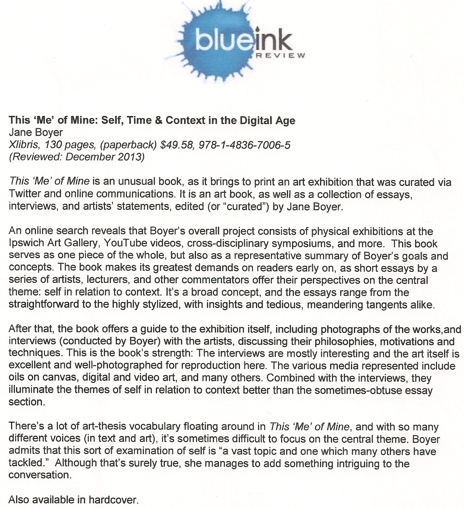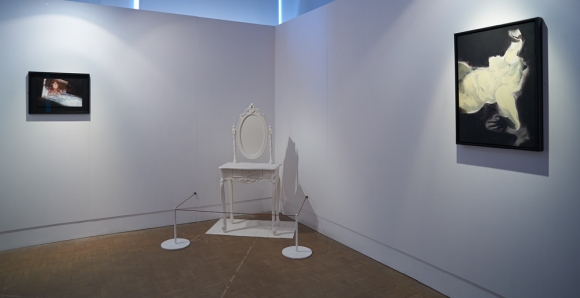
British & Foreign Beetles, ©2004 Annabel Dover, watercolour
‘Scientific observation and tender girlish enthusiasm’ is a curious mix of what seems to be diametrically opposed concepts and practices, but this description by Annabel of her own work is absolutely spot on. Not only does this describe her work but it also suggests there may be another way of approaching observation which includes fascination, delicacy and empathy; a gentle approach to observing the world which allows tenderness to remain, and to remain on equal footing with hard fact. Her works are as delicate as antique Venetian blown glass, and as fragile. Once in her gaze, the objects she works with are given to a relentless and crushing scrutiny; any individual subjected to this kind of probing would soon buckle under the intensity. Innately understanding this, Annabel satisfies herself with observing their objects; a kinder, gentler proposition but one no less penetrating into the soul by Annabel’s eye.
Jane Boyer: On your website you describe yourself as constantly being “drawn to objects and the invisible stories that surround them; [t]hrough their subtle representation…exploring their power as intercessionary agents that allow socially acceptable emotional expression. The work presents itself as a complex mixture of scientific observation and tender girlish enthusiasm which often belies their history.” That is a wonderful compendium of mystery, fact and fascination. Do they share equal weight in your explorations?

Christening Gown Ayrshire, ©2002 Annabel Dover, oil on board
Annabel Dover: I really enjoyed the show ‘Life or Theatre’ by Charlotte Salomans. It showed a very personal, fabulous fantasy representation of her life.
My upbringing was constructed from lies and my parents indulged in their own personal dramas. The truth was impossible to decipher and the objects that surrounded my sisters and I were often the only witnesses to ludicrous acts of fantasy and violence – the Freemason’s case with a bag of un-hewn rocks, a sign of dishonour; the naval coat with the buttons ripped off, indicators of an affair that my father had with a Naval officer; the college gown of my sisters’ father, an alcoholic professor; the love letters of his father, Canon for the BBC, to his fiancé; the jewellery that represented both my mother’s and my grandmother’s love affairs. These and many other objects highlighted the traumas and the breaks in human relationships that made up the atmosphere of my upbringing. The stories told to me by my family unravelled with the discovery of these indiscreet objects.
The personal stories people tell are fascinating to me, they announce who they would like to be and often contrast with how others might perceive them to actually be.

Water Garden, ©2012 Annabel Dover, water, plants, moss, glass dome
JB: A few years ago Anna White photographed your studio over the course of a year, she asked you to take your own photographs of your daily life and write down thoughts about your images. She included one of these texts and your accompanying photograph on her website. What strikes me is the association you make between the history of the rose bed outside your studio window and your own life history through the rose in the image. Association is a powerful tool for memory, can you explain some of the ways you use association in your work?
AD: I really love it when people communicate with me and I really felt this after the MA follow on show at Central St Martins. Lots of people came up to me and shared their stories. I had made a self-lit cubicle of roughly vitruvian proportions with a theatre blackout curtain and 365 small paintings inside. The images were of family photographs and things I had collected when I worked for an Antique dealer doing house clearances. I was touched by how many people felt a connection with images of other people’s belongings.

Iris’ Stocking, ©2011 Annabel Dover, cyanotype
JB: Your piece, Iris’ Stocking, is a life-size cyanotype of a woman’s seamed stocking from the 40’s. This is about all that can be gleaned from looking at the work, but the addition of the story behind this stocking gives an electrifying significance to the piece. Can you tell us more about the work, the stockings and the significance it all has for you?
AD: My grandmother kept a pair or gossamer thin silk stockings in a drawer along with a lipstick and a handkerchief ready for her husband’s return from the war. He never did return and was pronounced missing presumed dead. She kept these hidden and locked in her bureau and was found along with a photo of her husband in her wallet, after she died. She had remarried a horrible bully, my grandfather.
JB: Carol Mavor has written a beautiful fairy tale of your life, called Like Weeds. Much of your work deals with the stories attached to objects, or more specifically, the stories people tell of their objects. Do you think of these stories people tell as fairy tales of a sort? Can you describe or define the boundary between real life experience and when the experience becomes a story?

St. Anthony & Putti, ©2010 Annabel Dover, silverpoint
AD: I think they are. I think they change each time we tell them. My stepfather has dementia and no longer knows who I am. He was a POW in WWII and now when he talks about his time there it’s based on the plot of The Great Escape. I think we have always been characters in our own fairy tale. The essay Family Romances, [by Freud], talks about this:
“The child’s imagination becomes engaged in the task of getting free from the parents of whom he now has a low opinion and of replacing them by others, who, as a rule, are of higher social standing. He will make use in this connection of any opportune coincidences from his actual experience, such as his becoming acquainted with the Lord of the Manor or some landed proprietor if he lives in the country or with some member of the aristocracy if he lives in town. Chance occurrences of this kind arouse the child’s envy, which finds expression in a phantasy in which both his parents are replaced by others of better birth.”[1]
[1] Freud, S. (1909). Family Romances. The Standard Edition of the Complete Psychological Works of Sigmund Freud, Volume IX (1906-1908): Jensen’s ‘Gradiva’ and Other Works, 235
I’ve asked the artists to share a list of books they find informative for their practice. Follow the links here or visit the Bookshop to see all the books suggested so far. We hope you will see something inspiring for your own interests. Your book purchase made through This ‘Me’ of Mine will help raise funds for the project.
Annabel’s suggested reading:
Archaeology of Knowledge by Michel Foucoult
Art and Artifact by James Putnam
Biographical Objects by Janet Hoskins
Burning with Desire by Geoffrey Batchen
Charles Darwin and Victorian Visual Culture by Jonathan Smith
Reading Boyishly by Carol Mavor
The Archive edited by Charles Merewether
The Emancipated Spectator by Jacques Rancière
The Familial Gaze by Marianne Hirsch
The Politics of Focus by Lindsay Smith
Jane’s additions:
Grimm’s Fairy Tales
Briar Rose by Jane Yolen
If you enjoyed this interview, please follow This ‘Me’ of Mine by clicking the ‘follow’ button below. You can also follow us on Twitter and Facebook, those links are also below. Pop in and see the great work our partners are doing too! Click on the logos below to go to their sites.


















![[Imprint] Soft_Terrain (inverted), 2012 Sandra Crisp](https://thismeofmine.files.wordpress.com/2013/01/imprint_soft_terrain_i.jpg?w=580&h=580)







